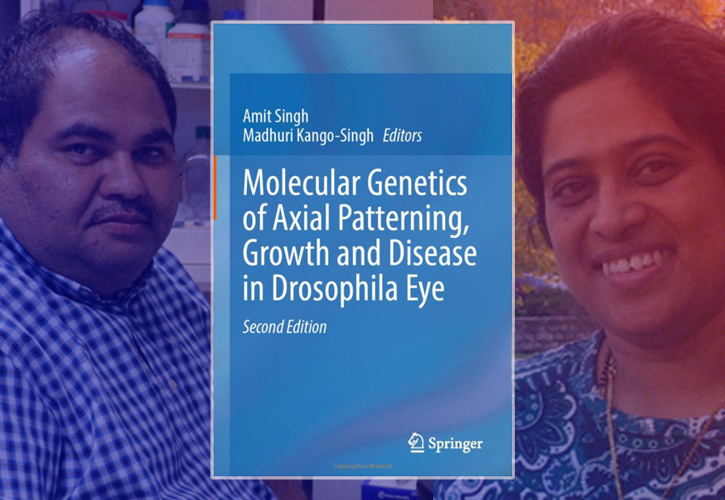College of Arts and Sciences Newsroom

University of Dayton geneticists publish new edition of fruit fly research book
By Dave Larsen
Two University of Dayton geneticists published the second edition of their well-received book about the fruit fly, a workhorse of the scientific world that provides researchers with powerful genetic tools to address questions that extend from basic biology to the development of human diseases.
Molecular Genetics of Axial Patterning, Growth and Disease in Drosophila Eye was released in May by Springer Publishing. The book was edited by Amit Singh, professor of biology and Schullein Chair in the Biological Sciences, and Madhuri Kango-Singh, associate professor of genetics in the Department of Biology. The married couple also contributed several book chapters, written independently with their research partners and graduate students.
The eye of the fruit fly — aka Drosophila melanogaster — is used extensively to determine how genes regulate axial patterning, the process of transforming a single layer of cells into a three-dimensional organ. Fruit fly genes are similar to those of humans, which allows researchers to model disorders such as cancer and Alzheimer’s, Parkinson’s and Huntington’s disease, among others.
“The life cycle of the fly is 12 days, so you can see two generations of fly life in a month’s time,” Singh said. “Whereas if you are a geneticist dealing with human disease and looking into a human population and trying to see how it is translated from one generation to the next, in your lifetime you can just see three generations. Working with flies, it looks like you’re watching a long movie on fast-forward, but the information generated here can be extrapolated to humans.”
First published in 2013, Molecular Genetics of Axial Patterning, Growth and Disease in Drosophila Eye covers current progress in the study of molecular genetic mechanisms of pattern formation, mutations in axial patterning, genetic regulation of growth and more using the fruit fly’s eye as a model. The second edition features contributions from a diverse group of international experts, with five new chapters and updates to the other seven.
“We tried to first come up with what aspects could be covered in this book, looked for people who worked in that area in Drosophila and then started contacting them,” Kango-Singh said. “We got a good response.”
The contributors include researchers from Emory University School of Medicine; Hillsdale College; Indiana University; Indiana State University; University of Minnesota School of Medicine; Vanderbilt University; University of Virginia; Wesleyan University; Washington University; the National Cancer Institute; Birla Institute of Technology and Science, India; Korea Advanced Institute of Science and Technology; and University of Fribourg, Switzerland.
The goal was to bring the latest insights from experts in the focused areas of fruit fly research into a single compilation that is accessible to readers.
“That’s where our work comes in,” Singh said. “When these researchers come with condensed articles, we work back-and-forth to make them reader-friendly, so in the end the essence of the information is as simplified as possible.”
Kango-Singh said writing something intended for use as an educational tool or a review of information is a different, but enjoyable process.
“As a team, we work well together,” she said. “We’ve been writing and collaborating for a pretty long time now.”
To date, they have published 30 research articles and edited two books. Kango-Singh also was a guest editor for special topic collections for Frontiers in Cell and Developmental Biology and Frontiers in Molecular Biosciences.
Kango-Singh’s research lab uses fruit flies as a model organism to identify genes that might play a role in human brain cancers, and to help understand how signaling interactions between cancer cells and other neighboring cells lead to uncontrolled cancer growth.
Singh’s research lab focuses on genetic defects in human eye development and early detection of Alzheimer’s disease, both using the fruit fly’s eye as a model. He has received nearly $1 million in federal and private research funding, including a $439,499 grant in 2017 from the National Institutes of Health to study early eye development in fruit flies in order to understand the molecular basis of retinal disease and birth defects in the human eye.
Molecular Genetics of Axial Patterning, Growth and Disease in Drosophila Eye is available in print and e-book editions from Amazon and Springer. The latter also has individual chapters available for download.
Singh said it is gratifying to have their book used as a resource in research labs and college classrooms. “The next generation of scientists are reading your book and it is helping them transform from a greenhorn to a full-fledged researcher.”
For more information, visit the Department of Biology website.
